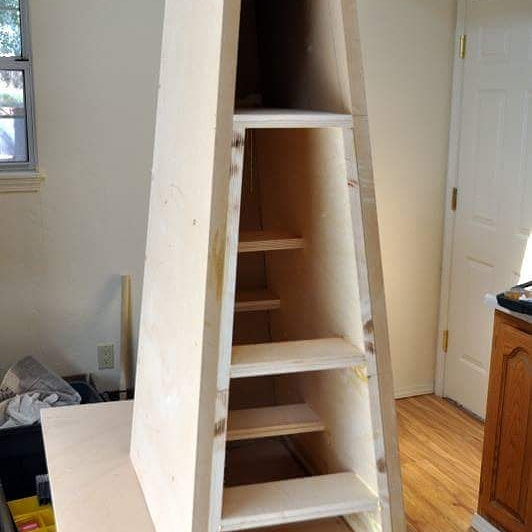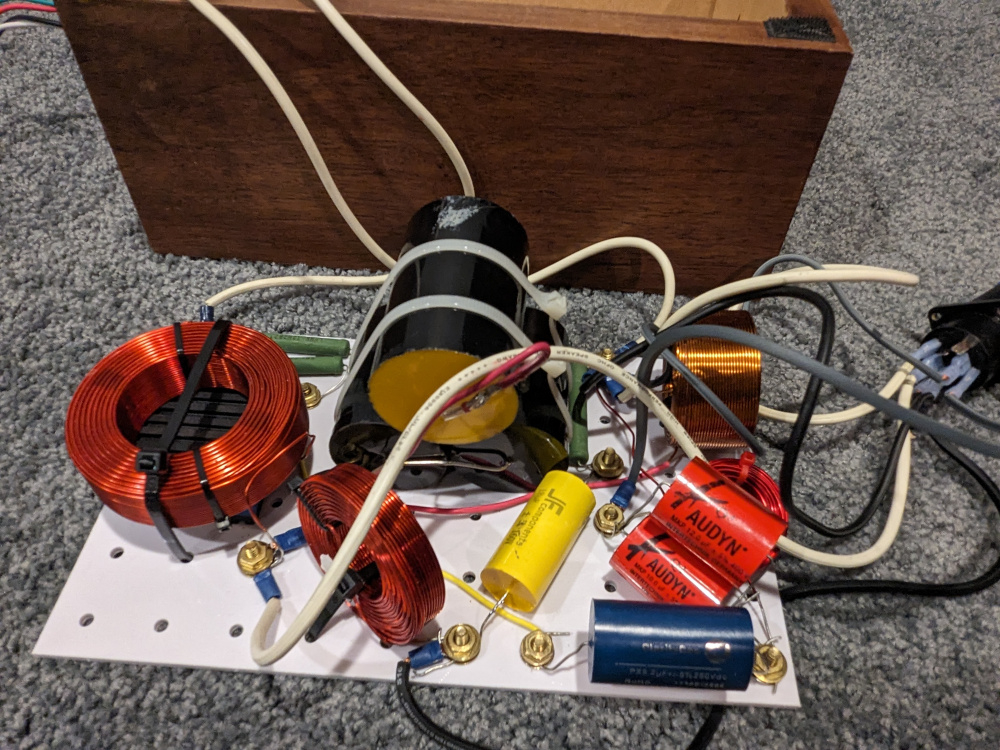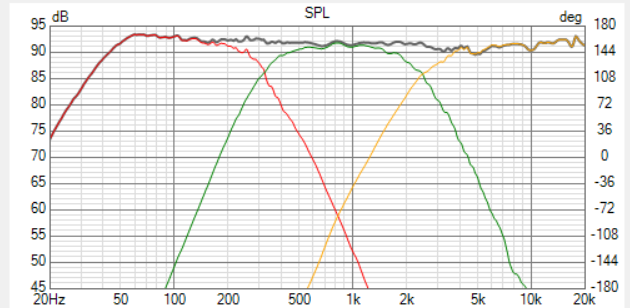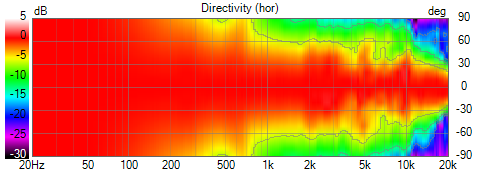Site Links
Howdy, Stranger!
It looks like you're new here. If you want to get involved, click one of these buttons!
Quick Links
Categories
Who's Online (0)
When is "done", done?
Way back in 2013, I built the "Last Hurrahs". They were to have been just as they are named. 2 X 8955A, U18, OW1. Heavy beasts with 1 3/4 inch sandwich panels, braced, with no parallel sides.
Yet, I've never been happy with them. So they sat in the corner, too much invested to abandon, yet not living up to my hopes. Over the years, I've tried several times to get them right. Different ports, damping, stuffing. Lots of XO work.
This time, though, I might be there. I finally got to the point where the model tracks the live measurement really, really well. Several of you have provided suggestions. So, I'm "mostly done" with the Last Hurrahs. Mostly because I want to upgrade a couple of parts. The JF capacitor in there seems prototyping quality for this project. I used Lynk resistors because that is what I had in needed values. Will probably upgrade these.
Done? You'll notice the external XO in a box. This nay make a final product eternally out of reach.
Check out the pics. Comments welcome. 








Comments
Wow, those are certainly top notch drivers. If you are aiming for "ultimate", make sure that off axis is looking and sounding good. I would be inclined to test some Clarity CSA caps in the crossover.
I have a CSA in the first tweeter position, Audyn in the second spot (may use CSA). Woofer shunt is Dayton 100uf polypro. Mid high-pass has a couple of paralleled Erse polypro to make 164uf total. The shunt on the low-pass is a JF 18uf MKP (will get replaced with something).
CSA's are expensive for the large values. But for the tweeter, what the heck.
rjj45, I could actually parallel some Clarity PX and CSA that I have to get the needed value for the tweeter. I wonder how that would work???
Never heard the Clarity PX, but I would have no qualms about paralleling a couple of caps.
But I don't have "golden ears" - very surprised that I easily heard a difference between Clarity CSA and Dayton / Audyn caps.
When you're happy with how it sounds in your room with your music and your ears.
If you're not happy with it, are you able to take some measurements? The more data the better, and some measurements on the listening axis and a few off axis angles would be very helpful eg.15/30/45/60
...If you're listening at 60 degrees off-ctr I'd suggest you tip your seater a bit more- jk (yes its all useful info)
I have to tell myself although it is a seemingly endless iterative process, at some point I have to choose between two or more equally pleasing outcomes. When I am trying to decide between a 3.3 and 3.9uF cap or an ohm of resistance I know am "there" and sometimes flip a coin between the two values. Well, not really but you know what I mean.
The risk when crossing over a 6.5" cone to a 0.75" dome is that the 6.5" has started to narrow near the top of its range eg. 2-4KHz but the 0.75" dome still has wide dispersion at the bottom of it's range ie. 2-4KHz, with a resultant wide-narrow-wide dispersion phenomenon.
This results in a sound power response that has a peak:
(sound) Power response is all of the sounds arriving at the listening position after any number of reflections from any direction. It is the weighted rms average of all 70 measurements (from on axis, ± 10º, ± 20º, ± 30º… ± 160, ± 170º, ± 180º horizontally and ± 10º, ± 20º, ± 30º… ± 160, ± 170º, ± 180º vertically) with individual measurements weighted according to the portion of the spherical surface that they represent.
This is the individual drive on axis:

If the baffle and drivers are already chosen (design is half-baked) the only way to change this is to move the crossover point higher and use a shallower slope eg. acoustic LR2 crossover:
The wide narrow wide dispersion phenomenon is minimized:

So despite the on-axis appearing much the same and judged as “flat”, the power response is much easier on the ear:
The only way to know if this was the problem in the first place is to take off axis measurements.
I would consider, as a minimum, taking horizontal off axis measurements at 15 degree intervals, up to 60 degrees, to identify if there is an issue.
LR4 crossover, lower crossover point.
LR2 crossover, higher XO point.
Ideally 10 degrees all the way to 90 degrees (or beyond) is better, but this takes considerable effort, particularly in the vertical plane.
@tktran - very instructive - thanks!
@tktran Thank you. I'm no engineer. I'm a psychologist. I use basic and a bit dated measurement tools to understand/verify what I hear and tweak. The only problems after 25 years at this are the ones I hear in my ancient leather listening chair. I voice from the chair, tweak from what I hear there. Off axis is not particularly interesting. Besides, the room modes/reflections are always in play.
This project is well beyond half-baked - as it built 10 years ago. Until now, I've not been completely satisfied. I can hear distortion when it is present, and I'm not hearing it now. I can hear errors of commission, and I'm not hearing them now. I can hear "phasey" and I like the soundstage now. I am interested at this point in not blowing something up - hence my other post on low impedance. I really honestly think I am finally done.
I’m glad you’re getting it done.
The interesting thing is all the measurements at all off axis angles, when weighted appropriately to give the power response, is actually very close to what is heard at the listening position, (predicted in-room response) because, as you say, it includes all the reflections. The one important difference is that it cannot predict the response below ~400Hz, where the room resonances are unique for any given room. For that you must use your ears to judge.
Here’s a video of an interview with Charles Sprinkle (ex-JBL) now at Kali Audio, giving a demo of how to measure the actual in-room response, at your listening position, and how it may be used to help tune your speakers:
To me it seems to converge with what our senses/brain has been telling us all along (psychology of acoustics)
What you experience (at your position), is what matters.
Our brains don't seem to object to anomalies down low, while they can be quite irritating further up.